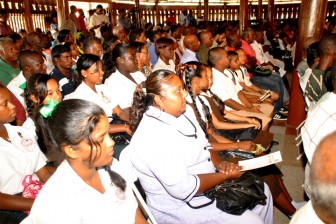More than a quarter of a century after having seemingly been written off as a failed experiment, the vehicle of the cooperative as an economic option for changing lives, maximizing production, increasing employment levels and contributing meaningfully to the growth of the Guyana economy is in the process of being restored to the national agenda.
In the wake of the official pronouncements made at the January 29 forum held at the Umana Yana to mark the launch of the United Nations-designated International Year of Cooperatives, Stabroek Business spoke with Chief Cooperatives Officer Kareem Abdul Jabar.

Jabar insisted that the spectacular collapse of cooperatives across the country by the early 1980s did not point to a fatal flaw in the concept of the cooperative itself. Rather, he said, many of the cooperatives that mushroomed in the decade of the 1970s were ill-conceived, as he put it, “fashioned on the wrong foundation.” Jabar said the successful cooperative must be built on a foundation of “collective felt needs and on the willingness of individuals to work together, voluntarily, to meet those needs.” Cooperatives, he says, “cannot be built on inducement,” which was what he believed obtained during the 1970s when the concept was driven much more by political direction than by people’s own recognition of the value of the cooperative.
“There were cases,” Jabar says, “in which individuals and groups were motivated by promises of things like tractors and land” and where the mushrooming of cooperative consumer societies that focused on food-distribution enterprises were the result of an officially recognized need to maximize food production in times of scarcity. He believes that in such cases rather less account was taken of the fact that cooperatives had to be run “like businesses” and that the vision, planning and skills required to run a successful business were sometimes altogether absent in the groups. Some of the groups which had little in common beyond the fact that their members lived in the same community, set about banding themselves into cooperatives. In such cases, Jabar says, “failure was perhaps inevitable.”
Still, Jabar insists that the failure of many of the earlier generation of cooperatives does not invalidate the case for cooperatives as a vehicle for profitable economic enterprise. He drew attention to those still existing cooperative societies that have not only survived the stigma associated but have emerged as viable business entities. He named the Skeldon Agricultural Society which he says earned around $350 million last year alone and the Port Mourant United Cooperative, one of the leading cane farming entities in Region Six as outstanding examples of cooperatives that have grown and prospered. There are too some consumers’ cooperative societies, like the Guyana Police Consumer Cooperative Socie-ty, which, today, is being run along the lines of the scores of privately-run supermarkets that have mushroomed over the last two decades.

There are, too, a number of cooperative credit unions, like those being run by the Guyana Public Service and the Guyana Defence Force; enterprises that have not only grown steadily over the years but which continue to provide a lending lifeline for public sector employees challenged by seemingly unending liquidity problems. Estimates of the numbers of public and private sector employees who are members of cooperative credit unions range from 8,000 to 12,000; beyond the obvious success stories, Jabar said, the psychological impact of the cooperative village has left its mark on communities across Guyana. In Region Four, for example, there are still more than 100 functioning cooperative societies while other regions have fewer, some operating in the agriculture and craft-production sectors. There may be as many as 200 functioning cooperatives across the country though Jabar admits the levels of efficiency and productivity vary from one instance to another.
Under the Forbes Burnham administration the cooperative had been earmarked as the dominant sector of the Guyana economy, a vehicle through which large numbers of unemployed people, mostly living in the same communities, could earn a living through a single collective pursuit. In other cases cooperatives were centred around the application of collective endeavour to achieve other objectives: housing for communities. Some of the cooperative sector’s more spectacular failures, however, including those in the agricultural sector, had led to the conclusion that collective economic endeavour by groups of people with little if any understanding of how to manage a business enterprise could hardly realize the kind of successful outcome that manifests itself in orthodox private sector enterprise.
At the January 29 ceremony to mark the launch of International Year of Cooperatives, Chief Executive Officer of the Guyana Small Business Bureau and Chairman of the Committee of Management of the Guyana National Cooperative Union Ltd Derrick Cummings, disclosed that government intended to seek “strategic support from the donor community to re-engineer the cooperative movement for rebirth and sustainability.” It is, Cummings subsequently told Stabroek Business, an opportunity to restore the cooperative to the pride of place which it once held as a high-profile sector in the Guyana economy. He shares Jabar’s view that the rebuilding of a cooperative sector must take account of the need for shrewd management.
Jabar agrees that attempts to revive cooperatives must take account of the transformations that have taken place in the Guyana economy. While the government has committed itself to seeking external support to help revitalize the movement, such support is likely to be given in the form of technical expertise rather than in the form of what Jabar calls “inducements and handouts” that cause cooperatives to seem like gravy trains. More than that, in a society where, the cooperative sector having long lost its place—it is the private sector that is now the dominant sector in the society—cooperatives must now prove their worth as vehicles for economic progress.
Jabar at least is optimistic. He believes the current era of a dominant private sector has created a greater awareness of bringing a “business orientation” to the management of enterprises.
Part of his explanation for the failure of many cooperatives and for the attendant loss of face which the cooperative suffered as a viable economic option has to do with what is perhaps the political ‘pampering’ that attended the existence of many of the earlier generation of cooperatives. His own research, he said, led him to the interesting discovery that some cooperatives of the pre-independence era accomplished much more for members than the succeeding generation of collectives. The reasons, he said, have to do with clarity of purpose, the entrepreneurial focus of members and the absence of the kinds of official inducements that robbed many of the succeeding generation of cooperatives of a motive of their own. Jabar is pinning his hopes on the fact that the prevailing environment of economic competition resulting from the dominance of a growing private sector will, in the future, require the cooperative movement to earn its place in the Guyana economy.





